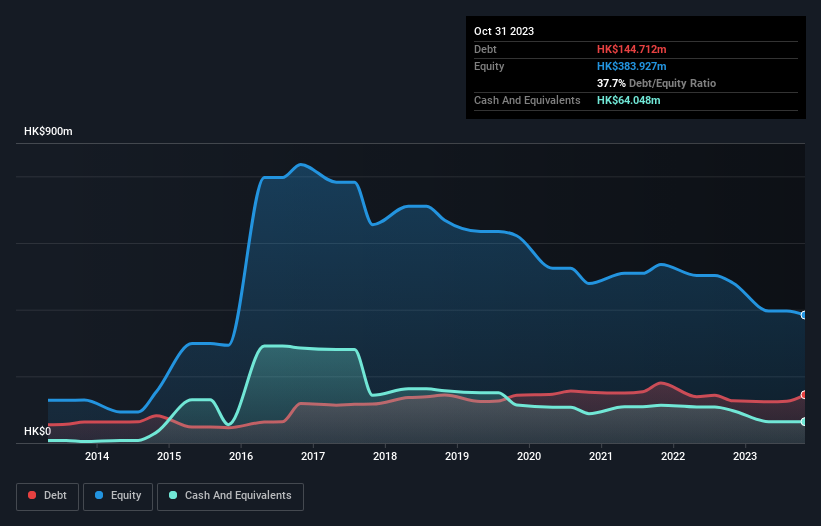- Hong Kong
- /
- Construction
- /
- SEHK:8021
These 4 Measures Indicate That WLS Holdings (HKG:8021) Is Using Debt Reasonably Well

The external fund manager backed by Berkshire Hathaway's Charlie Munger, Li Lu, makes no bones about it when he says 'The biggest investment risk is not the volatility of prices, but whether you will suffer a permanent loss of capital.' It's only natural to consider a company's balance sheet when you examine how risky it is, since debt is often involved when a business collapses. We can see that WLS Holdings Limited (HKG:8021) does use debt in its business. But is this debt a concern to shareholders?
When Is Debt Dangerous?
Generally speaking, debt only becomes a real problem when a company can't easily pay it off, either by raising capital or with its own cash flow. Ultimately, if the company can't fulfill its legal obligations to repay debt, shareholders could walk away with nothing. While that is not too common, we often do see indebted companies permanently diluting shareholders because lenders force them to raise capital at a distressed price. By replacing dilution, though, debt can be an extremely good tool for businesses that need capital to invest in growth at high rates of return. The first thing to do when considering how much debt a business uses is to look at its cash and debt together.
Check out our latest analysis for WLS Holdings
What Is WLS Holdings's Net Debt?
The image below, which you can click on for greater detail, shows that at October 2023 WLS Holdings had debt of HK$144.7m, up from HK$126.4m in one year. However, because it has a cash reserve of HK$64.0m, its net debt is less, at about HK$80.7m.

How Healthy Is WLS Holdings' Balance Sheet?
We can see from the most recent balance sheet that WLS Holdings had liabilities of HK$192.8m falling due within a year, and liabilities of HK$1.22m due beyond that. On the other hand, it had cash of HK$64.0m and HK$493.4m worth of receivables due within a year. So it actually has HK$363.4m more liquid assets than total liabilities.
This surplus strongly suggests that WLS Holdings has a rock-solid balance sheet (and the debt is of no concern whatsoever). On this view, lenders should feel as safe as the beloved of a black-belt karate master.
In order to size up a company's debt relative to its earnings, we calculate its net debt divided by its earnings before interest, tax, depreciation, and amortization (EBITDA) and its earnings before interest and tax (EBIT) divided by its interest expense (its interest cover). Thus we consider debt relative to earnings both with and without depreciation and amortization expenses.
WLS Holdings's net debt is sitting at a very reasonable 2.5 times its EBITDA, while its EBIT covered its interest expense just 4.6 times last year. While that doesn't worry us too much, it does suggest the interest payments are somewhat of a burden. Pleasingly, WLS Holdings is growing its EBIT faster than former Australian PM Bob Hawke downs a yard glass, boasting a 412% gain in the last twelve months. There's no doubt that we learn most about debt from the balance sheet. But it is WLS Holdings's earnings that will influence how the balance sheet holds up in the future. So if you're keen to discover more about its earnings, it might be worth checking out this graph of its long term earnings trend.
Finally, a business needs free cash flow to pay off debt; accounting profits just don't cut it. So the logical step is to look at the proportion of that EBIT that is matched by actual free cash flow. During the last three years, WLS Holdings burned a lot of cash. While that may be a result of expenditure for growth, it does make the debt far more risky.
Our View
The good news is that WLS Holdings's demonstrated ability to grow its EBIT delights us like a fluffy puppy does a toddler. But the stark truth is that we are concerned by its conversion of EBIT to free cash flow. Taking all this data into account, it seems to us that WLS Holdings takes a pretty sensible approach to debt. That means they are taking on a bit more risk, in the hope of boosting shareholder returns. There's no doubt that we learn most about debt from the balance sheet. But ultimately, every company can contain risks that exist outside of the balance sheet. For instance, we've identified 3 warning signs for WLS Holdings (1 is potentially serious) you should be aware of.
When all is said and done, sometimes its easier to focus on companies that don't even need debt. Readers can access a list of growth stocks with zero net debt 100% free, right now.
Valuation is complex, but we're here to simplify it.
Discover if WLS Holdings might be undervalued or overvalued with our detailed analysis, featuring fair value estimates, potential risks, dividends, insider trades, and its financial condition.
Access Free AnalysisHave feedback on this article? Concerned about the content? Get in touch with us directly. Alternatively, email editorial-team (at) simplywallst.com.
This article by Simply Wall St is general in nature. We provide commentary based on historical data and analyst forecasts only using an unbiased methodology and our articles are not intended to be financial advice. It does not constitute a recommendation to buy or sell any stock, and does not take account of your objectives, or your financial situation. We aim to bring you long-term focused analysis driven by fundamental data. Note that our analysis may not factor in the latest price-sensitive company announcements or qualitative material. Simply Wall St has no position in any stocks mentioned.
About SEHK:8021
WLS Holdings
An investment holding company, provides scaffolding, fitting out, and other auxiliary services for the construction and building works businesses in Hong Kong.
Adequate balance sheet low.


